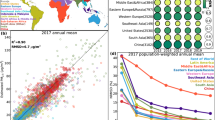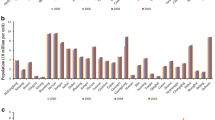Abstract
Exposure to fine particulate matter (PM2.5) is known to harm public health. In China, after implementation of aggressive emissions control measures under the Action Plan of Air Pollution Prevention and Control (2013–2017), air quality has significantly improved. In this work, we investigated changes in PM2.5 exposure and the associated health impacts in China for the period 2013–2017. We used an optimal estimator of PM2.5 combining in-situ observations, satellite measurements, and simulations from a chemical transport model to derive the spatial and temporal variations in PM2.5 exposure, and then used well-developed exposure-response functions to estimate the premature deaths attributable to PM2.5 exposure. We found that national population-weighed annual mean PM2.5 concentrations decreased from 67.4 µg m−3 in 2013 to 45.5 µg m−3 in 2017 (32% reduction). This rapid decrease in PM2.5 pollution led to a 14% reduction in premature deaths due to long-term exposure. We estimated that, during 2013–2017, the premature deaths attributable to long-term PM2.5 exposure decreased from 1.2 million (95% CI: 1.0, 1.3; fraction of total mortality: 13%) in 2013 to 1.0 million (95% CI: 0.9, 1.2; 10%) in 2017. Despite the rapid decrease in annual mean PM2.5 concentrations, health benefits associated with reduced long-term exposure were limited, because for many cities, the PM2.5 levels remain at the portion where the exposure-response function is less steeper than that at the low-concentration end. We also found that the deaths associated with acute exposure decreased by 61% during 2013–2017 due to rapid reduction in the number of heavily polluted days. Our results confirm that clean air policies in China have mitigated the air pollution crisis; however, continuous emissions reduction efforts are required to protect citizens from air pollution.
Similar content being viewed by others
References
Analitis A, Katsouyanni K, Dimakopoulou K, Samoli E, Nikoloulopoulos A K, Petasakis Y, Touloumi G, Schwartz J, Anderson H R, Cambra K, Forastiere F, Zmirou D, Vonk J M, Clancy L, Kriz B, Bobvos J, Pekkanen J. 2006. Short-term effects of ambient particles on cardiovascular and respiratory mortality. Epidemiology, 17: 230–233
Bell M L, Zanobetti A, Dominici F. 2013. Evidence on vulnerability and susceptibility to health risks associated with short-term exposure to particulate matter: A systematic review and meta-analysis. Am J Epidemiol, 178: 865–876
Burnett R T, Pope C A, Ezzati M, Olives C, Lim S S, Mehta S, Shin H H, Singh G, Hubbell B, Brauer M, Anderson H R, Smith K R, Balmes J R, Bruce N G, Kan H, Laden F, Prüss-Ustün A, Turner M C, Gapstur S M, Diver W R, Cohen A. 2014. An integrated risk function for estimating the global burden of disease attributable to ambient fine particulate matter exposure. Environ Health Perspect, 122: 397–403
Cai S, Wang Y, Zhao B, Wang S, Chang X, Hao J. 2017. The impact of the “Air Pollution Prevention and Control Action Plan” on PM2.5 concentrations in Jing-Jin-Ji region during 2012–2020. Sci Total Environ, 580: 197–209
Chen G, Li S, Knibbs L D, Hamm N A S, Cao W, Li T, Guo J, Ren H, Abramson M J, Guo Y. 2018. A machine learning method to estimate PM2.5 concentrations across China with remote sensing, meteorological and land use information. Sci Total Environ, 636: 52–60
Cohen A J, Brauer M, Burnett R, Anderson H R, Frostad J, Estep K, Balakrishnan K, Brunekreef B, Dandona L, Dandona R, Feigin V, Freedman G, Hubbell B, Jobling A, Kan H, Knibbs L, Liu Y, Martin R, Morawska L, Pope C A, Shin H, Straif K, Shaddick G, Thomas M, van Dingenen R, van Donkelaar A, Vos T, Murray C J L, Forouzanfar M H. 2017. Estimates and 25-year trends of the global burden of disease attributable to ambient air pollution: An analysis of data from the global burden of diseases study 2015. Lancet, 389: 1907–1918
Di Q, Kloog I, Koutrakis P, Lyapustin A, Wang Y, Schwartz J. 2016. Assessing PM2.5 exposures with high spatiotemporal resolution across the continental United States. Environ Sci Technol, 50: 4712–4721
Gao M, Guttikunda S K, Carmichael G R, Wang Y, Liu Z, Stanier C O, Saide P E, Yu M. 2015. Health impacts and economic losses assessment of the 2013 severe haze event in Beijing area. Sci Total Environ, 511: 553–561
Gao M, Saide P E, Xin J, Wang Y, Liu Z, Wang Y, Wang Z, Pagowski M, Guttikunda S K, Carmichael G R. 2017. Estimates of health impacts and radiative forcing in winter haze in Eastern China through constraints of surface PM2.5 predictions. Environ Sci Technol, 51: 2178–2185
GBD MAPS Working Group. 2016. Burden of disease attributable to coal-burning and other major sources of air pollution in China. Special Report 20. Boston: Health Effects Institute
Guan T, Xue T, Liu Y, Zheng Y, Fan S, He K, Zhang Q. 2018. Differential susceptibility in ambient particle-related risk of first-ever stroke: Findings from a national case-crossover study. Am J Epidemiol, 187: 1001–1009
Huang J, Pan X, Guo X, Li G. 2018. Health impact of China’s air pollution prevention and control action plan: An analysis of national air quality monitoring and mortality data. Lancet Planet Health, 2: e313–e323
Künzli N, Medina S, Kaiser R, Quenel P, Horak J F, Studnicka M. 2001. Assessment of deaths attributable to air pollution: Should we use risk estimates based on time series or on cohort studies? Am J Epidemiol, 153: 1050–1055
Lepeule J, Laden F, Dockery D, Schwartz J. 2012. Chronic exposure to fine particles and mortality: An extended follow-up of the Harvard Six Cities study from 1974 to 2009. Environ Health Perspect, 120: 965–970
Lin A, Pu Y, Qi W, Li X, Li X, Wang C, Yang X J. 2016. China’s partial emission control. Science, 351: 674–675
Lin C Q, Liu G, Lau A K H, Li Y, Li C C, Fung J C H, Lao X Q. 2018. High-resolution satellite remote sensing of provincial PM2.5 trends in China from 2001 to 2015. Atmos Environ, 180: 110–116
Liu J, Han Y, Tang X, Zhu J, Zhu T. 2016. Estimating adult mortality attributable to PM2.5 exposure in China with assimilated PM2.5 concentrations based on a ground monitoring network. Sci Total Environ, 568: 1253–1262
Liu M, Huang Y, Ma Z, Jin Z, Liu X, Wang H, Liu Y, Wang J, Jantunen M, Bi J, Kinney P L. 2017. Spatial and temporal trends in the mortality burden of air pollution in China: 2004–2012. Environ Int, 98: 75–81
Liu T, Cai Y, Feng B, Cao G, Lin H, Xiao J, Li X, Liu S, Pei L, Fu L, Yang X, Zhang B, Ma W. 2018. Long-term mortality benefits of air quality improvement during the twelfth five-year-plan period in 31 provincial capital cities of China. Atmos Environ, 173: 53–61
Lu F, Xu D Q, Cheng Y B, Dong S X, Guo C, Jiang X, Zheng X Y. 2015. Systematic review and meta-analysis of the adverse health effects of ambient PM2.5 and PM10 pollution in the Chinese population. Environ Res, 136: 196–204
Ma Z, Hu X, Sayer A M, Levy R, Zhang Q, Xue Y, Tong S, Bi J, Huang L, Liu Y. 2015. Satellite-based spatiotemporal trends in PM2.5 concentrations: China, 2004–2013. Environ Health Perspectives, 124: 184–192
Pope C A, Muhlestein J B, May H T, Renlund D G, Anderson J L, Horne B D. 2006. Ischemic heart disease events triggered by short-term exposure to fine particulate air pollution. Circulation, 114: 2443–2448
Pope C A, Turner M C, Burnett R T, Jerrett M, Gapstur S M, Diver W R, Krewski D, Brook R D. 2015. Relationships between fine particulate air pollution, cardiometabolic disorders, and cardiovascular mortality. Circ Res, 116: 108–115
Shaddick G, Thomas M L, Amini H, Broday D, Cohen A, Frostad J, Green A, Gumy S, Liu Y, Martin R V, Pruss-Ustun A, Simpson D, van Donkelaar A, Brauer M. 2018. Data integration for the assessment of population exposure to ambient air pollution for global burden of disease assessment. Environ Sci Technol, 52: 9069–9078
Shi L, Zanobetti A, Kloog I, Coull B A, Koutrakis P, Melly S J, Schwartz J D. 2016. Low-concentration PM2.5 and mortality: Estimating acute and chronic effects in a population-based study. Environ Health Perspect, 124: 46–52
Song C, He J, Wu L, Jin T, Chen X, Li R, Ren P, Zhang L, Mao H. 2017. Health burden attributable to ambient PM2.5 in China. Environ Pollut, 223: 575–586
Sun D, Fang J, Sun J. 2018. Health-related benefits of air quality improvement from coal control in China: Evidence from the Jing-Jin-Ji region. Resour Conser Recycl, 129: 416–423
U.S. EPA, 2012. Provisional Assessment of Recent Studies on Health Effects of Particulate Matter Exposure. U.S. Environmental Protection Agency, Washington, DC, EPA/600/R-12/056, 2012
van Donkelaar A, Martin R V, Brauer M, Hsu N C, Kahn R A, Levy R C, Lyapustin A, Sayer A M, Winker D M. 2016. Global estimates of fine particulate matter using a combined geophysical-statistical method with information from satellites, models, and monitors. Environ Sci Technol, 50: 3762–3772
Wang J, Wang S, Voorhees A S, Zhao B, Jang C, Jiang J, Fu J S, Ding D, Zhu Y, Hao J. 2015. Assessment of short-term PM2.5-related mortality due to different emission sources in the Yangtze River Delta, China. Atmos Environ, 123: 440–448
Wang Q, Wang J, He M Z, Kinney P L, Li T. 2018. A county-level estimate of PM2.5 related chronic mortality risk in China based on multi-model exposure data. Environ Int, 110: 105–112
Xie R, Sabel C E, Lu X, Zhu W, Kan H, Nielsen C P, Wang H. 2016. Long-term trend and spatial pattern of PM2.5 induced premature mortality in China. Environ Int, 97: 180–186
Xue T, Zheng Y X, Geng G, Zheng B, Jiang X J, Zhang Q, He K B. 2017. Fusing observational, satellite remote sensing and air quality model simulated data to estimate spatiotemporal variations of PM2.5 exposure in China. Remote Sens, 9: 221
Yang G, Wang Y, Zeng Y, Gao G F, Liang X, Zhou M, Wan X, Yu S, Jiang Y, Naghavi M, Vos T, Wang H, Lopez A D, Murray C J. 2013. Rapid health transition in China, 1990–2010: Findings from the global burden of disease study 2010. Lancet, 381: 1987–2015
Zheng Y X, Xue T, Zhang Q, Geng G N, Tong D, Li X, He K B. 2017. Air quality improvements and health benefits from China’s clean air action since 2013. Environ Res Lett, 12: 114020
Acknowledgements
This work was supported by the National Natural Science Foundation of China (Grant Nos. 41571130032, 41571130035, 41625020 & 41701591) and the National Key R & D Program (Grant No. 2016YFC0201506).
Author information
Authors and Affiliations
Corresponding author
Electronic supplementary material
Rights and permissions
About this article
Cite this article
Xue, T., Liu, J., Zhang, Q. et al. Rapid improvement of PM2.5 pollution and associated health benefits in China during 2013–2017. Sci. China Earth Sci. 62, 1847–1856 (2019). https://doi.org/10.1007/s11430-018-9348-2
Received:
Revised:
Accepted:
Published:
Issue Date:
DOI: https://doi.org/10.1007/s11430-018-9348-2




